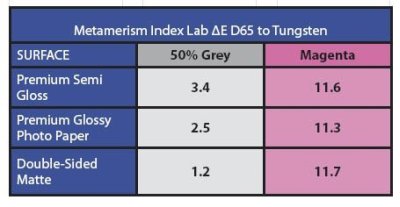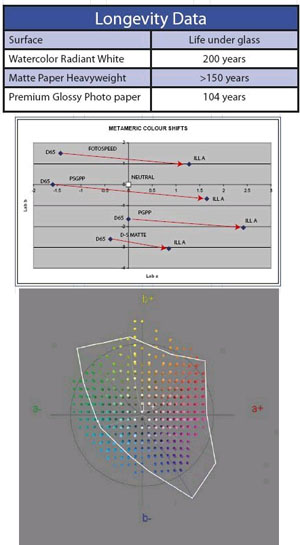articles/Printers/8steps-page3
8 Steps to Perfection - part 3 of 1 2 3
by Mike McNamee Published 01/06/2006

Epson Double-Sided Matte
We audited this media using the generic profile provided on the Epson CD ("SPR 1800 D-S Matte paper"). It turned in a really first-class performance with an average error of 8.4 Lab ÄE. The surface is not as cool as the PGPP and the skin tones are closer for this reason. The Dmax was 1.58, good for this type of matt media. Surprisingly, in view of having an additional blue ink, the printer delivered the poorest error in the spectral blue, at 29.0 ÄE Lab. This flaw was not however detectable in the images we printed; the eye is not very sensitive to variations in that part of the spectrum, as long as the hue does not shift towards purple.
The greys from this combination were excellent; the Macbeth mid grey was a tiny, 1.1ÄE, from perfection! Metamerism was also low at 1.2ÄE. The grey linearity was well handled by the profile and although the plot has a few bumps in it, the detailed was maintained all the way down to 5 RGB points, something that a bespoke profile rarely achieves. The tonal scale stopped at 17% brightness, typical for a matt paper of this type. We made a monochrome print using these settings and the print looked very good indeed, amongst the best we have seen from an inkjet.

Metamerism
In case you need reminding, metamerism is the mismatch of colours, which occurs when you view them despite the fact that they matched in a different type of light. The brain is able to remember colours such that if you take a print from your tungsten-lit lounge to your conservatory the print may be neutral in one room and off-colour in the other. As the UltraChrome HiGloss is a new type of ink it is relevant to collate the metamerism data. We measure metamerism using a spectrophotometer which has the facility to compare the colour in different lights. In order to standardise we measure a neutral 50% grey in standardised daylight, the so-called D65 light and standardised tungsten light, the so-called Illuminant A. We also measured the full magenta swatch. The difference is measured in Lab ÄE units, the bigger the value the worse the result; in all instances the colour shift was from blue or cyan towards more magenta.
Connectivity
The R1800 may be connected via Firewire or USB 2.
Running Costs
As the cartridge set is the same as the R800, the cost calculations we made for the R800 probably apply, namely about £1.25 worth of ink for a 10x8 inch print.
Fade Resistance
The table below is compiled from data posted on the Wilhelm website www.wilhelm-research.com.
Conclusion
The R1800 continues from where Longevity Datathe R800 started, although it is a lot more accurate out of the box. With its fast, silent operation and high fade resistance it is sure to find a home on many professional operations. At £399.99 inclusive of VAT it provides an ideal start for at-base printing. The high operating cost will not trouble those who are selling their prints at realistic margins. The gamut map to the right says it all - this printer is yet another leap forward in inkjet printing - it had not escaped our notice that the Epson 4000 already has eight cartridge slots - "Are you thinking what we're thinking?" Well we thought incorrectly. Since drafting this piece, the seven new large format printers have been announced and they contain three blacks and no red or blue or glop!
Please Note:
There is more than one page for this Article.
You are currently on page 3 Contact Mike McNamee
1st Published 01/06/2006
last update 09/12/2022 14:50:43
More Printers Articles
There are 0 days to get ready for The Society of Photographers Convention and Trade Show at The Novotel London West, Hammersmith ...
which starts on Wednesday 15th January 2025





